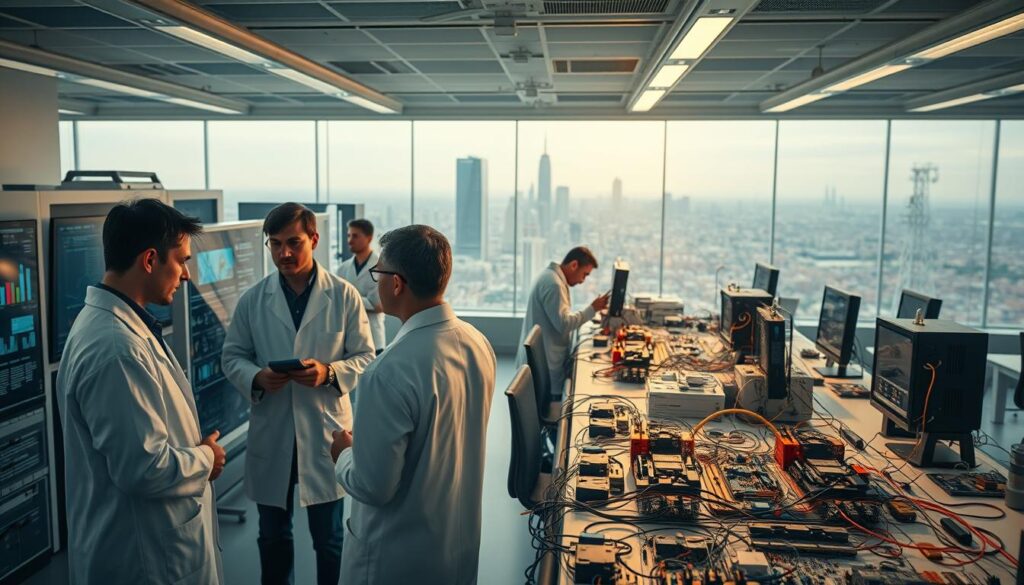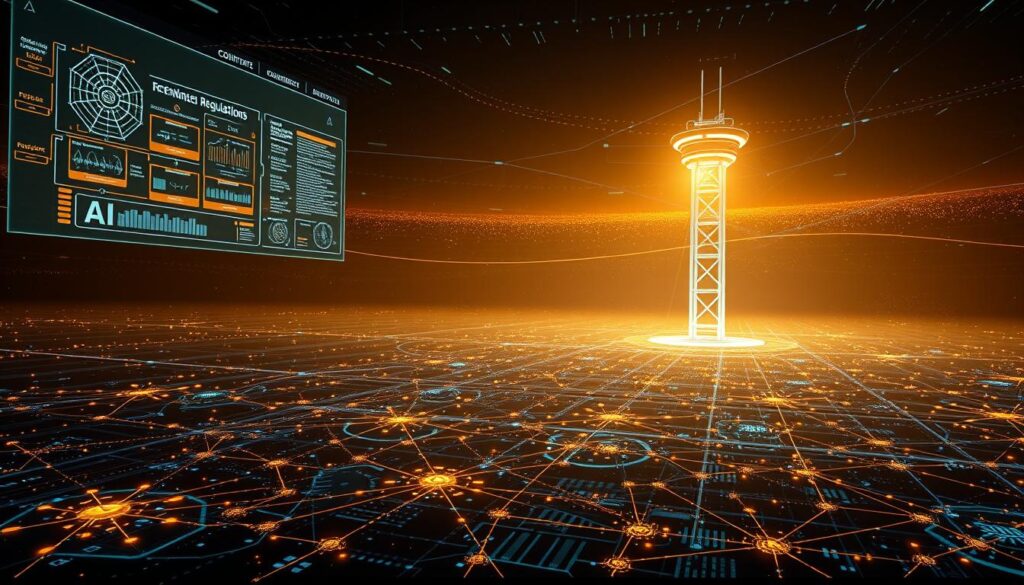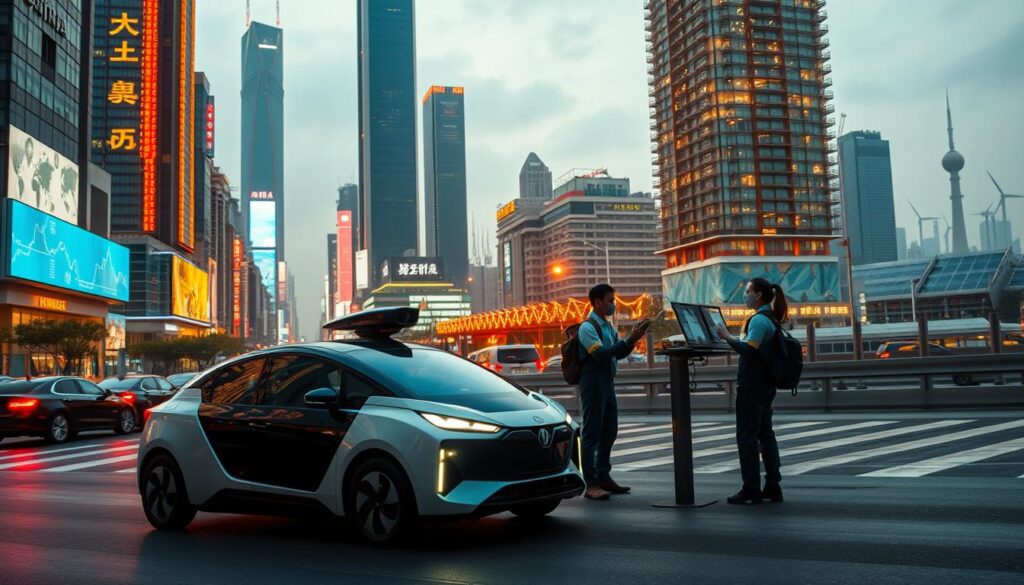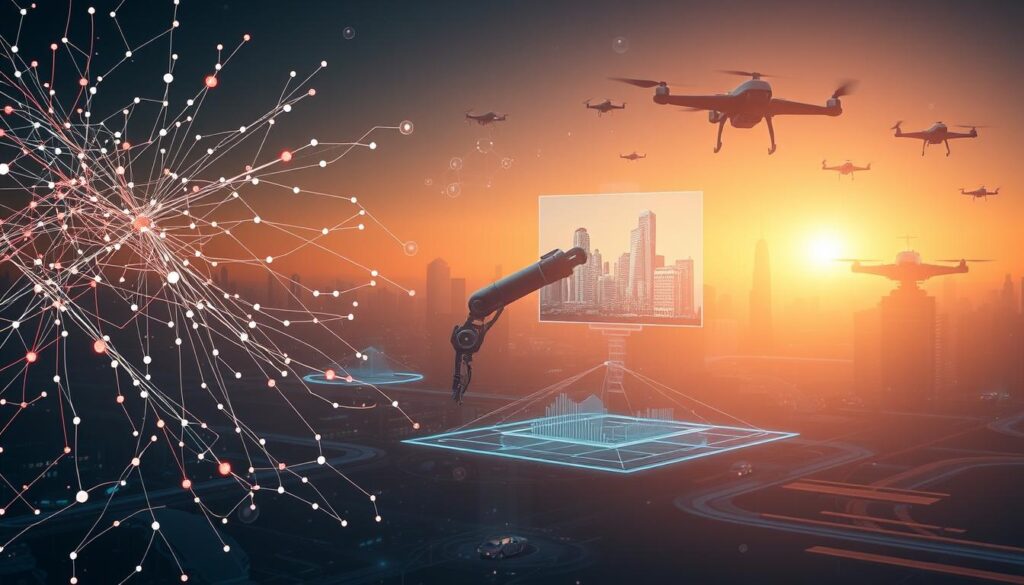Artificial intelligence is reshaping the world, and China is at the forefront of this transformation. With its vast investments in technology and government-backed initiatives, the nation is leveraging AI to drive innovation across multiple sectors. From healthcare to autonomous vehicles, the impact of artificial intelligence is profound and far-reaching.
China’s approach to AI is comprehensive, focusing on national security, economic growth, and societal benefits. For instance, AI-driven drug discovery has already entered clinical trials, showcasing the potential of this technology in healthcare1. Additionally, the integration of large language models is revolutionizing industries, with companies like Alibaba leading the charge2.
The government plays a pivotal role in fostering AI development. Through subsidies and strategic investments, it supports domestic companies and ensures the growth of this critical technology. This proactive stance has positioned China as a global leader in artificial intelligence, influencing trends and setting benchmarks worldwide.
Key Takeaways
- China is leveraging artificial intelligence to transform sectors like healthcare and transportation.
- Government-backed initiatives are driving AI innovation and adoption.
- AI-driven drug discovery is advancing rapidly, with clinical trials already underway.
- Large language models are being integrated into various industries, enhancing efficiency.
- Strategic investments and subsidies are supporting the growth of domestic AI companies.
AI Transformations in China’s Healthcare Industry

The healthcare sector in China is undergoing a remarkable transformation, driven by cutting-edge technology. Artificial intelligence is at the heart of this change, revolutionizing diagnostics, drug discovery, and patient care. With significant government backing, the nation is setting new benchmarks in healthcare innovation.
AI-Driven Drug Discovery and Diagnostics
Pharmaceutical companies are leveraging AI to accelerate drug development. For instance, the first drug discovered using generative AI entered clinical trials in 2023, taking less than 18 months and costing under $3 million3. This is a stark contrast to traditional methods, which often take six years and cost over $18 million.
AI is also refining diagnostics. At Ruijin Hospital, AI-powered tools reduce diagnosis time for pathological slides from 40 minutes to mere seconds4. Such advancements are critical in a country where the ratio of radiologists is 1 per 70,000 people, compared to 1 per 7,000 in the US3.
The Rise of MedGPT and Large Language Models in Healthcare
MedGPT, an AI-powered chatbot, is transforming patient care by handling diagnoses and prescriptions. This tool aligns with the expertise of top hospital doctors, providing accurate treatment recommendations4. Over 50 AI healthcare vertical large models have been released by domestic enterprises, focusing on triage and medical image interpretation4.
The integration of large language models is enhancing efficiency across the industry. For example, AI-powered robots can reduce surgical time by 30%, a significant improvement in high-volume hospitals like Beijing Children’s Hospital4.
With the market for AI-empowered healthcare expected to grow by nearly 25% annually from 2025 to 2030, the future looks promising3. To learn more about integrating AI in healthcare, visit this resource.
AI Innovations in Autonomous Vehicles in China

Self-driving cars are no longer a futuristic dream but a present-day reality in many parts of the world. China is leading this transformation, with significant advancements in electric vehicle (EV) technologies and autonomous systems. The country’s focus on innovation has positioned it as a global leader in this sector.
Advancements in Electric Vehicle Technologies
China’s EV market is booming, driven by enhanced connectivity and cutting-edge self-driving systems. Companies like Huawei and Xiaomi are at the forefront, showcasing their latest models at events like the Beijing Autoshow. These innovations are not only improving vehicle performance but also reducing environmental impact.
For instance, Xpeng Motors aims to mass-produce Level 3 autonomous driving technology by 2025, with plans to explore Level 4 capabilities by 20265. Similarly, GAC Group is testing Level 3 autonomous vehicles on public roads, with mass production expected by 20255.
Self-Driving Systems and Safety Protocols
Safety is a top priority in the development of autonomous vehicles. Advanced sensor-driven algorithms and safety protocols are being implemented to ensure reliability. In Wuhan, Baidu operates the largest fleet of robot taxis, with 400 vehicles covering an area of 1,160 square miles6.
Beijing has also installed cameras and sensors at 300 road intersections to aid autonomous vehicle navigation6. These measures highlight the country’s commitment to creating a safe and efficient transportation system.
“The integration of autonomous vehicles with road infrastructure is a game-changer, enhancing safety and efficiency.”
| City | Autonomous Vehicles | Key Features |
|---|---|---|
| Wuhan | 400 robot taxis | 1,160 sq. miles coverage |
| Beijing | 900 autonomous vehicles | 300 sensor-equipped intersections |
Younger consumers are driving market trends, favoring vehicles with advanced AI features. Government initiatives, such as the AI Plus initiative, are further accelerating the adoption of autonomous technologies5. These efforts are shaping the future of transportation, not just in China but across the world.
China’s AI Impact on Power Demand and Electrical Infrastructure

The rapid expansion of artificial intelligence is reshaping global energy demands, with China leading the charge in infrastructure upgrades. As AI technologies grow, they are placing unprecedented pressure on power grids, requiring significant reforms to meet rising consumption7.
AI-specific power demand is projected to grow tenfold by 2026, driven by data centers and advanced computing needs7. This surge is pushing upgrades in electrical infrastructure, particularly in transformer technologies and grid management systems8.
Upgrading Electrical Grids with AI Insights
Chinese grid companies are leveraging AI to optimize energy distribution and reduce costs. For instance, the Tianshu-1 system has cut energy consumption by over 15% through predictive analytics and maintenance9.
However, technical challenges remain. Transformer and grid equipment manufacturers face rising costs due to the need for advanced materials and technologies8. These upgrades are essential to ensure reliability and efficiency in the face of growing demand.
Case studies highlight China’s competitive edge. With over 90% smart meter penetration, the nation is better equipped to manage energy consumption compared to the U.S., where penetration stands at 72%8.
| Country | Smart Meter Penetration | Energy Efficiency Initiatives |
|---|---|---|
| China | 90% | AI-driven grid optimization |
| United States | 72% | Subsidies for green energy |
Looking ahead, AI insights will continue to shape infrastructure reforms. The interplay between technological innovations and energy efficiency will be critical in sustaining growth9. For more on AI’s role in transforming industries, visit this resource.
Government Policies and Regulatory Frameworks for AI

China’s approach to AI governance is setting new standards for ethical practices. The nation has introduced comprehensive regulations to ensure responsible development and deployment of artificial intelligence. These measures address critical areas like recommendation algorithms, transparency, and national security.
In 2021, the regulation on recommendation algorithms marked a significant milestone. It established guidelines to prevent price discrimination, control content, and protect workers’ rights10. This framework has since become the backbone of AI governance, ensuring alignment with state objectives.
Regulatory Measures on Recommendation Algorithms
The algorithm registry is a key component of these policies. It enhances transparency by requiring companies to disclose how their algorithms operate10. This step ensures accountability and builds public trust in AI technologies.
Additionally, the regulations address ethical concerns. Generative AI service providers must implement measures to prevent discrimination based on nationality, religion, or gender10. These rules promote fairness and inclusivity in AI applications.
“Transparency in AI algorithms is essential to ensure fairness and accountability in their use.”
These policies also contribute to broader national security and market reforms. By regulating AI applications, the government aims to mitigate risks like data leakage and adversarial attacks11. This proactive approach ensures balanced growth in the AI industry.
| Regulation | Effective Date | Key Focus |
|---|---|---|
| Recommendation Algorithms | March 1, 2022 | Price discrimination, content control |
| Generative AI Measures | August 15, 2023 | Ethical use, discrimination prevention |
The end goal of these policies is to create a sustainable and ethical AI ecosystem. By fostering transparency and accountability, China is shaping the future of AI governance. These efforts set a benchmark for other nations to follow.
The Strategic Role of AI in National Security and Surveillance

The strategic integration of artificial intelligence into national security systems is transforming surveillance and predictive analytics. AI-driven tools are enhancing the ability to monitor and respond to threats in real-time, ensuring state control and public safety12.
Predictive analytics powered by AI are being used to identify potential risks before they escalate. For instance, Hikvision’s surveillance cameras can automatically identify adversarial targets, improving response times and accuracy13. These advancements are critical in maintaining national security.
Large language models play a significant role in monitoring and regulating information. They analyze vast amounts of data to detect patterns and anomalies, ensuring compliance with state policies14. This capability is essential for managing public discourse and protecting sensitive data.
Research initiatives and market investments are driving the development of AI security tools. The Shanghai AI Lab, for example, is a leading producer of technical research on AI safety, producing accompanying policy papers12. These efforts highlight the competitive market dimensions that fuel innovation.
Technological development is closely tied to broader content management strategies. The CCP’s Third Plenum in 2024 called for the establishment of oversight systems for AI safety, emphasizing its risks to employment, privacy, and international relations12.
| Initiative | Focus Area | Impact |
|---|---|---|
| Shanghai AI Lab | Technical Research | AI safety and policy development |
| Hikvision Surveillance | Adversarial Target Identification | Improved response times |
| CCP Third Plenum | Oversight Systems | National security and privacy protection |
These advancements underscore the importance of AI in shaping national security. By leveraging predictive tools and surveillance systems, the nation is setting new benchmarks in safety and control13.
Advancing Research and Industry Competitiveness with AI

Collaborations between academia and industry are driving innovation in artificial intelligence. These partnerships combine academic expertise with practical applications, creating a powerful synergy that accelerates progress. By working together, universities and companies are refining AI models and developing specialized tools that address real-world challenges15.
One notable example is the joint effort between Tsinghua University and Alibaba. Their collaboration has led to breakthroughs in natural language processing, enhancing AI services across multiple sectors16. Such projects highlight the importance of shared intellectual resources in advancing industry standards.
Collaborative Research Projects
Research initiatives between academic institutions and tech giants are yielding impressive results. For instance, the partnership between Peking University and Huawei focuses on improving AI algorithms for autonomous systems. This project has already produced a model that reduces computational costs by 20%17.
Another example is the collaboration between Shanghai Jiao Tong University and Tencent. Together, they developed a tool that optimizes data processing for large-scale AI applications. This innovation has significantly improved efficiency in industries like healthcare and finance15.
| Institution | Industry Partner | Key Achievement |
|---|---|---|
| Tsinghua University | Alibaba | Breakthroughs in NLP |
| Peking University | Huawei | Cost-efficient AI algorithms |
| Shanghai Jiao Tong University | Tencent | Data processing optimization |
These partnerships not only bolster research but also enhance market competitiveness. By integrating academic insights with industry needs, they create a sustainable ecosystem for AI innovation16.
Looking ahead, the trend of joint innovation is expected to grow. As more institutions and companies collaborate, the potential for groundbreaking advancements in AI technology will continue to expand17.
China’s AI Governance: Reverse Engineering Regulations

China’s regulatory framework for artificial intelligence is evolving through a unique reverse engineering process. This approach involves analyzing existing technologies and adapting policies to address emerging challenges. By systematically refining regulations, the nation ensures that AI development aligns with national priorities18.
Key Policy Documents and Bureaucratic Drivers
In late 2021, China introduced the world’s first comprehensive regulation for recommendation algorithms, marking a significant milestone in AI governance18. This policy set guidelines to prevent price discrimination and control content, ensuring alignment with state objectives. The Cyber Space Administration of China (CAC) plays a central role in enforcing these measures, driving transparency and accountability19.
By early 2023, the CAC expanded its focus to include generative AI, releasing draft measures that were finalized within three months18. These rules mandate security assessments and algorithm registration for services that shape public opinion, making China the first country to implement such requirements18.
Technical Performance Standards and Reporting
Technical standards are a cornerstone of China’s AI governance. The algorithm registry enhances transparency by requiring companies to disclose how their systems operate19. This mechanism ensures that AI applications meet rigorous performance benchmarks, fostering public trust and compliance.
Reporting requirements are equally stringent. Generative AI providers must submit detailed documentation on their systems’ functionality and ethical safeguards18. These measures underscore the state’s commitment to maintaining security and mitigating risks associated with AI technologies.
“Transparency in AI algorithms is essential to ensure fairness and accountability in their use.”
| Policy | Effective Date | Key Focus |
|---|---|---|
| Recommendation Algorithms | March 1, 2022 | Price discrimination, content control |
| Generative AI Measures | August 15, 2023 | Security assessments, algorithm registration |
China’s approach to AI governance is influencing global debates on regulation. By reverse engineering its policies, the nation is setting a benchmark for balancing innovation with ethical considerations19. For more insights into AI governance, visit this resource.
How Does China Use AI to Drive Economic Growth

Economic growth in China is increasingly fueled by advancements in artificial intelligence, transforming industries and boosting productivity. The integration of AI into key sectors like manufacturing, finance, and logistics is driving efficiency and innovation. By leveraging language models and advanced information systems, decision-making frameworks have become more precise and effective20.
In manufacturing, AI-powered automation is reducing costs and increasing output. For example, predictive maintenance systems are minimizing downtime, while smart factories are optimizing production lines21. These applications are not only enhancing productivity but also creating new areas of economic opportunity.
The financial sector is also benefiting from AI-driven innovations. Algorithms are improving risk assessment and fraud detection, while chatbots are enhancing customer service. These advancements are contributing to a more robust and secure financial ecosystem20.
“AI is not just a technological advancement; it’s a catalyst for economic transformation.”
Logistics is another area where AI is making a significant impact. Route optimization and inventory management systems are streamlining operations, reducing costs, and improving delivery times. These improvements are crucial for maintaining competitiveness in a global market21.
| Sector | AI Application | Economic Impact |
|---|---|---|
| Manufacturing | Predictive Maintenance | Reduced downtime, increased output |
| Finance | Risk Assessment Algorithms | Improved security, better customer service |
| Logistics | Route Optimization | Lower costs, faster deliveries |
Looking ahead, the potential for AI to drive economic growth is immense. With continued investment and innovation, China is poised to remain a global leader in AI adoption and its economic benefits. For more insights into AI’s role in economic transformation, visit this resource.
Exploring Emerging AI Technologies and Applications

The rapid evolution of artificial intelligence technologies is unlocking new possibilities across industries. From advanced language models to innovative software, these tools are reshaping how businesses operate and compete. China’s tech landscape is at the forefront of this transformation, with groundbreaking developments that address specific needs and goals within the industry22.
One of the most significant breakthroughs is in the development of large language models. These models are enhancing applications in fields like healthcare, finance, and logistics. For instance, over 180 large language models were approved for general use by August 2024, showcasing the scale of innovation16.
Innovative Tools and Software Developments
Emerging AI tools are not just theoretical; they are already making a tangible impact. For example, Shenzhen’s AI industrial zones are home to high-performance computing centers, with plans to achieve 4,000 PFLOPS of computing power22. This infrastructure supports the development of cutting-edge applications that drive efficiency and productivity.
Another area of focus is the integration of AI into legal frameworks. The Cyberspace Administration of China has established regulations to ensure transparency and accountability in AI systems. These measures align with the broader law and ethical standards, fostering trust in AI technologies23.
| City | AI Focus Area | Key Achievement |
|---|---|---|
| Shenzhen | High-Performance Computing | 4,000 PFLOPS computing power |
| Beijing | General Algorithms | 19.29% market share in 2023 |
| Shanghai | AI Ecosystem | Over 1,100 core AI companies |
These advancements are not limited to China. The global impact of these technologies is evident, with AI influencing industries worldwide. For more on how AI is transforming finance, visit this resource.
The transformative potential of AI is immense. By addressing specific needs and aligning with ethical laws, these technologies are setting new benchmarks for innovation. The goal is to create a sustainable ecosystem that benefits both industry and society22.
Global Perspectives on Chinese AI Regulation
Global policymakers are closely monitoring China’s AI regulatory framework, which is reshaping international norms. The nation’s detailed and binding rules, such as the “Measures for Generative AI Services,” are among the most specific globally24. These regulations are influencing global strategy and setting benchmarks for ethical AI governance.
China’s approach to AI governance is often compared to Western practices. While Western regulations emphasize individual privacy, China focuses on national security and public interest25. This divergence highlights the challenges of harmonizing global AI policies. Scholars argue that these differences could lead to fragmented governance, complicating cross-border technology exchanges24.
Impact on the International Market and Security
China’s AI regulations are reshaping international markets. The draft “Artificial Intelligence Law” mandates data security and privacy protections, requiring companies to safeguard personal information24. These measures are influencing global competition, as companies must adapt to comply with diverse regulatory frameworks.
Security is another critical area. China’s focus on national security in AI governance is prompting other nations to reassess their policies. For instance, the “Trustworthy AI White Paper” emphasizes risk management and accountability, setting a precedent for global security standards25.
“China’s AI regulations are not just shaping its domestic landscape but are also influencing global governance and security frameworks.”
The integration of large language models into global markets is another area of focus. China’s policies on algorithm filing and security assessments are influencing how these technologies are adopted internationally24. This trend underscores the need for collaborative efforts to ensure ethical and efficient AI deployment.
Looking ahead, the global community must navigate the complexities of AI governance. China’s proactive approach offers valuable lessons but also raises questions about the future of international competition and cooperation in AI development.
Understanding Global Impact: How Does China Use AI
The global influence of artificial intelligence policies and technological advancements is reshaping international diplomacy and policy frameworks. China’s aggressive adoption and regulation of AI are setting new benchmarks, affecting nations worldwide. These developments present both opportunities and challenges for international adoption, particularly for the United States and other democratic societies.
Implications for the United States and Other Democracies
China’s AI advancements serve as a vehicle for global influence, particularly in areas like surveillance and predictive analytics. For U.S. policymakers, adapting to these models poses significant challenges. The export of AI technologies, backed by state initiatives, is reshaping global markets and security frameworks26.
For instance, China’s “New Generation Artificial Intelligence Development Plan” outlines a comprehensive strategy to lead in AI by 2030, with an expected annual economic contribution of $600 billion27. This plan not only boosts domestic growth but also influences international standards and practices.
Opportunities and Challenges for International Adoption
The international adoption of Chinese AI technologies offers opportunities for innovation and efficiency. However, it also raises concerns about data security and ethical governance. The “Interim Measures for the Management of Generative Artificial Intelligence Services” established in 2023 provides a framework for addressing these issues26.
One major challenge is the divergence in regulatory approaches. While Western nations emphasize individual privacy, China focuses on national security and public interest. This difference complicates global cooperation and harmonization of AI policies28.
“China’s AI regulations are not just shaping its domestic landscape but are also influencing global governance and security frameworks.”
To navigate these complexities, international collaboration is essential. The “Global Initiative for AI Governance” launched in October 2023 highlights China’s commitment to fostering ethical AI practices globally28. For more insights into AI’s role in global transformation, visit this resource.
In conclusion, China’s AI advancements are reshaping global diplomacy and policy. While they offer significant opportunities for innovation, they also present strategic challenges that require careful navigation. By fostering collaboration and addressing ethical concerns, the global community can harness the potential of AI for a sustainable future.
Conclusion
The transformative power of artificial intelligence is reshaping industries, governance, and global dynamics. From healthcare to energy, AI drives innovation, enhances security, and challenges traditional market norms. China’s advancements in AI patents and clean energy highlight its leadership in this space29.
Regulatory frameworks and technological advancements play a role in addressing both domestic and international demand. Policies like the “Measures for Generative AI Services” ensure ethical practices while fostering growth29. These efforts underscore the connection between technology, policy, and economic progress.
Looking ahead, the evolution of AI governance will continue to influence global trends. As nations adapt to these changes, collaboration and innovation will remain key to harnessing AI’s full potential.
FAQ
What role does AI play in China’s healthcare sector?
How is AI advancing autonomous vehicles in China?
How does AI impact China’s power demand and infrastructure?
What are China’s key AI regulatory measures?
How does AI contribute to China’s national security?
What is the role of AI in China’s economic growth?
What emerging AI technologies is China focusing on?
How does China’s AI regulation impact the global market?
What are the implications of China’s AI use for other countries?
How does China promote AI research and industry collaboration?
Source Links
- How AI is shaping industries in China | J.P. Morgan Research
- How Innovative Is China in AI?
- The Future of Healthcare: How China’s medical industry is adopting AI – CKGSB Knowledge
- China Focus: China accelerates AI adoption to transform medical services
- AI expected to accelerate self-driving tech
- China speeds up permission to test self-driving vehicles – Marketplace
- How much energy will AI really consume? The good, the bad and the unknown
- China’s Overlooked AI Energy Edge Over the US: Cheaper Energy
- China’s AI future in a quest for geopolitical, computing and electric power
- AI Watch: Global regulatory tracker – China | White & Case LLP
- China-releases-AI-safety-governance-framework | DLA Piper
- China’s Views on AI Safety Are Changing—Quickly
- China’s Military Employment of Artificial Intelligence and Its Security Implications — THE INTERNATIONAL AFFAIRS REVIEW
- China’s AI Policy & Development: What You Need to Know
- Strategic Reorientation on AI Competition with China
- Assessing China’s AI development and forecasting its future tech priorities
- China’s Domestic AI Competition Heats Up
- China and Artificial Intelligence: The Cold War We’re Not Fighting
- China’s advances could boost AI’s impact on global GDP
- China’s AI Revolution: The Global Tech Power Shift – The Geopolitics
- Exploring China’s Leading AI Hubs: A Regional Analysis
- China’s Artificial Intelligence Law: Everything You Need to Know
- An Analysis of China’s AI Governance Proposals | Center for Security and Emerging Technology
- China And AI In 2025: What Global Executives Must Know To Stay Ahead
- China’s AI development model in an era of technological deglobalization
- China’s AI Governance: Engaging the Global South
- China Closing AI-Innovation Gap with the US







